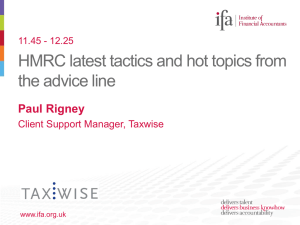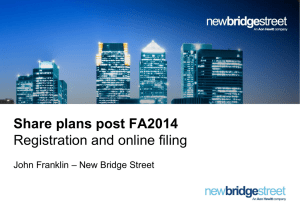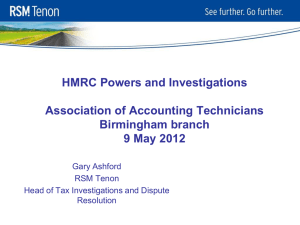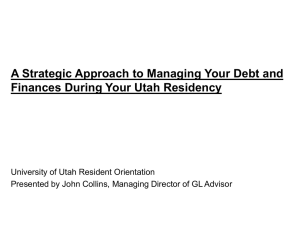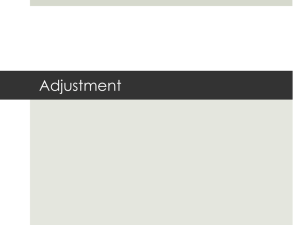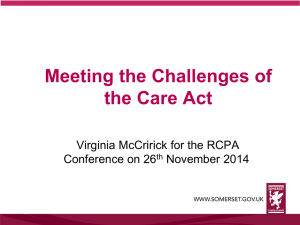April_Quarterly_Workshop
advertisement
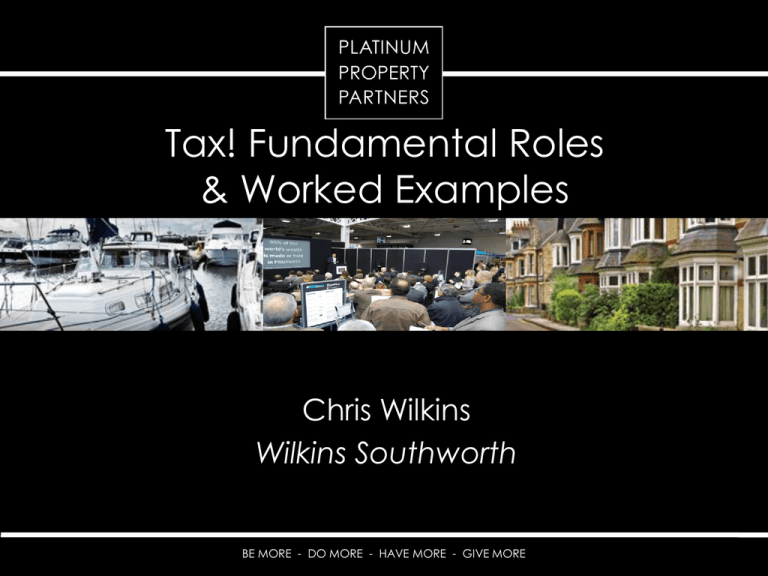
Tax! Fundamental Roles & Worked Examples Chris Wilkins Wilkins Southworth BE MORE - DO MORE - HAVE MORE - GIVE MORE Overview 1. 2. 3. 4. 5. 6. 7. Abolition of The Renewals Basis VAT 708 Sideways Loss Relief Real Time Information (RTI) National Employment Savings Trust (NEST) High Income Child Benefit Charge Tax Cases - Emoluments, dividends or both? - Overdraft or loan interest? Relief For Interest on Loans To A Close Company Payments Under Guarantees 8. Dutch Sandwich BE MORE - DO MORE - HAVE MORE - GIVE MORE The Renewals Basis BE MORE - DO MORE - HAVE MORE - GIVE MORE The Renewals Basis • HMRC announced that the concessionary renewals allowance for the replacement of plant other than trade tools will be withdrawn with effect from April 2013. • S.68 ITTOIA 2005 gives a specific deduction for the cost of replacing tools that are used for the purposes of a trade. • By concession, before the introduction of capital allowances for plant and machinery, this treatment (known as the ‘renewals basis’) was extended to expenditure on other plant and machinery, on the following main conditions: BE MORE - DO MORE - HAVE MORE - GIVE MORE The Renewals Basis - No capital allowances or other deductions are available on the cost of the original asset, which must be disposed of before a renewals allowance can be claimed (S.35 CAA 2001). - No relief is available for the cost of any improvement of the replacement asset. BE MORE - DO MORE - HAVE MORE - GIVE MORE Wear & Tear Allowance? BE MORE - DO MORE - HAVE MORE - GIVE MORE The Renewals Basis What happens now? a) Where a residential property is let furnished, the 10% ‘wear and tear’ allowance in respect of the depreciation of plant and fixtures can be claimed. - An allowance for wear and tear may be made, where capital allowances are not due, by deducting 10% of the net rent received. - Where the 10% deduction is allowed, no further deduction is given for the cost of renewing furniture or furnishings, including suites, beds, carpets, curtains, linen, crockery or cutlery. BE MORE - DO MORE - HAVE MORE - GIVE MORE The Renewals Basis - Nor is a further deduction allowed for chattels of a type, which in unfurnished accommodation, a tenant would normally provide for himself (for example cookers, washing machines, dishwashers). - However, in addition to the 10% wear and tear allowance, the landlord can also claim the cost of renewing fixtures which are an integral part of the buildings and which are revenue repairs to the fabric. These are fixtures which would not normally be removed by either tenant or owner if the property were vacated or sold (for example, baths, washbasins, toilets and central heating boilers). Expenditure on renewing such items may be treated as expenditure on repairs even though the 10% allowance has been claimed Extra Statutory Concession ESC B47 BE MORE - DO MORE - HAVE MORE - GIVE MORE The Renewals Basis b) Where a residential property is let unfurnished • A furnished property is one that is capable of normal occupation without the tenant having to provide their own beds, chairs, tables, sofas and other furnishings, cookers etc. The provision of nominal furnishings will not meet this requirement. If the accommodation is not furnished, or only partly furnished, the 10% wear and tear allowance is not due. • HMRC Property Income Manual PIM 3200 BE MORE - DO MORE - HAVE MORE - GIVE MORE Detailed Profit & Loss Account Example ABC LIMITED – YEAR ENDED 31ST AUGUST 2012 BE MORE - DO MORE - HAVE MORE - GIVE MORE Detailed Profit & Loss Account Example ABC LIMITED – YEAR ENDED 31ST AUGUST 2012 BE MORE - DO MORE - HAVE MORE - GIVE MORE Wear & Tear Allowance ABC LIMITED – YEAR ENDED 31ST AUGUST 2012 In accordance with ESCB47 an allowance for wear and tear can be made, where capital allowances are not due, by deducting 10% of the net rent received. For this purpose the net rent is calculated by deducting charges and services that would normally be borne by a tenant but are instead, borne by the landlord. If we assume for the purposes of this example that the accounts figures for the year ended 31 August 2013 will be the same as 31 August 2012. The wear and tear allowance we can claim is as follows:BE MORE - DO MORE - HAVE MORE - GIVE MORE Wear & Tear Allowance ABC LIMITED – YEAR ENDED 31ST AUGUST 2012 BE MORE - DO MORE - HAVE MORE - GIVE MORE VAT 708 BE MORE - DO MORE - HAVE MORE - GIVE MORE VAT 708 • In order to qualify for the reduced rate of VAT of just 5%, a residential conversion must result in a multiple occupancy dwelling, such as where a self-contained dwelling is converted into a number of non-self contained ones. • The reduced rate of VAT is also applicable where a multiple occupancy dwelling that has been empty for at least two years, is renovated or altered (prior to 1 January 2008, the dwelling had to have been empty for three years). BE MORE - DO MORE - HAVE MORE - GIVE MORE VAT 708 What ‘multiple occupancy dwelling’ means: • A ‘multiple occupancy dwelling’ is defined in Value Added Tax Act 1994, Schedule 7A, Group 6, paragraph 4 of the notes. BE MORE - DO MORE - HAVE MORE - GIVE MORE VAT 708 What ‘designed for occupation by persons not forming a single household’ means: • A dwelling designed for ‘persons not forming a single household’ is a building (or part of a building) where the living space is to varying degrees shared by persons not forming a single household. A typical example would be a block of bedsits, where the occupant households share the amenities – for example, the bathroom or the kitchen. BE MORE - DO MORE - HAVE MORE - GIVE MORE VAT 708 • Excluded from the meaning of ‘dwellings designed for persons not forming a single household’ are buildings that are used to any extent for a relevant residential purpose. The clause, which was introduced with effect from 1 June 2000, clarifies that the terms refer to different and distinct types of property. • A dwelling is ‘designed’ as a ‘multiple occupancy dwelling’ if it is built for that purpose (and not subsequently altered to something different – for example, offices), or has been altered to that purpose from some other use – for example, a barn. BE MORE - DO MORE - HAVE MORE - GIVE MORE VAT 708 Conditions: • VCONST14120, VCONST14130 and VCONST14140 apply in the same way as they do for buildings ‘designed as a dwelling or number of dwellings’. • A dwelling consists of self-contained living accommodation when the basic elements of living (sleeping, washing, preparation of food, and so on) are located together within a defined area and are not shared by more than one household or tenant. BE MORE - DO MORE - HAVE MORE - GIVE MORE VAT 708 • A ‘bed-sit’ wouldn't qualify as self-contained living accommodation because some of the elements of living are shared with other ‘bed-sits’, whereas a studio flat where all the elements of living are contained within the flat would be self-contained living accommodation. BE MORE - DO MORE - HAVE MORE - GIVE MORE VAT 708 In Agudas Israel Housing Association Ltd (VTD 18798), the Tribunal held that a bedsitting room with en suite shower room (one of eight), constructed as an enlargement to an existing care home, was self-contained living accommodation. In this case, the VAT tribunal said: ‘in the 21st Century premises with their own front door, ensuite bathing facilities and the ability to cook with a microwave and kettle are self contained living accommodation’. BE MORE - DO MORE - HAVE MORE - GIVE MORE VAT 708 In Oldrings Development Kingsclere Limited (VTD 17769), the Tribunal held that a new studio room did consist of self-contained living accommodation. It contained certain facilities such as a WC with hand basin in a separate room, a kitchen sink and sufficient electrical points for cooking appliances, its own separate central heating and hot water system but it didn't have a shower unit or bath installed. BE MORE - DO MORE - HAVE MORE - GIVE MORE VAT 708 In SA Whiteley (VTD 11292), the Tribunal held that the use of the singular of ‘a building’ in Note 2 meant that the basic elements of living had to be contained within one building and not spread around several buildings. BE MORE - DO MORE - HAVE MORE - GIVE MORE Sideways Loss Relief BE MORE - DO MORE - HAVE MORE - GIVE MORE Sideways Loss Relief • Whereas previously there has been no limit on the amount of losses that can be offset against general income, a cap will now be set at £50,000 or 25% of your adjusted total income, whichever is the greater. • The cap will not apply to ‘limited reliefs’ such as pension contributions, Seed Enterprise Investment Schemes (SEIS), Enterprise Investment Schemes (EIS) and Venture Capital Trusts (VCT). BE MORE - DO MORE - HAVE MORE - GIVE MORE Sideways Loss Relief • The reliefs which will potentially be capped within the new regime are: – Share loss relief – Trade loss relief against income – Early trade loss relief – Post cessation trade relief – Property loss relief against income eg. capital allowances – Post cessation property relief – Employment loss relief BE MORE - DO MORE - HAVE MORE - GIVE MORE Sideways Loss Relief - Example • Mr Dawson has trade losses in 2014/15 of £200,000 and 2013/14 profits from the same trade of £70,000. • He has other income in each tax year of £120,000. • Mr Dawson’s relief against general income is restricted to £50,000 for both the 2013/14 and 2014/15 tax years. • He then elects to set £50,000 (capped) against his 2014/15 general income and to carry back £70,000 against 2013/14 profits from the same trade. • He also claims to carry back £50,000 against his general income in 2013/14. BE MORE - DO MORE - HAVE MORE - GIVE MORE Sideways Loss Relief - Example Mr Dawson’s taxable income for the respective tax years is as follows:- BE MORE - DO MORE - HAVE MORE - GIVE MORE Real Time Information (RTI) BE MORE - DO MORE - HAVE MORE - GIVE MORE Real Time Information (RTI) • HMRC are introducing major changes in the way PAYE information is reported to them. • The Real Time Information procedures mark the biggest change in the Payroll and PAYE system since the commencement of PAYE nearly 70 years ago. BE MORE - DO MORE - HAVE MORE - GIVE MORE Real Time Information (RTI) • Under RTI, employers and pension providers are required to provide detailed information to HMRC in respect of more or less all wages/salaries on or before each payment date, instead of after the end of the tax year. • This system of Real Time reporting is designed to ensure that HMRC has both up to date and accurate details of employment income and tax deductions for all PAYE taxpayers, thereby reducing the number of end of tax year reconciliations with resultant underpayments and repayments. BE MORE - DO MORE - HAVE MORE - GIVE MORE Real Time Information (RTI) • This will provide the Department of Work & Pensions with up to date information regarding claimants’ employment income, enabling calculations of Universal Tax Credit payments to be made on a monthly basis without the need for further information submissions by individual claimants. BE MORE - DO MORE - HAVE MORE - GIVE MORE Real Time Information (RTI) • Some aspects that will remain the same, in particular employers will still use codes to determine the amount of tax to be deducted from employees, P60s, P45s and P11Ds will continue to be used and PAYE/NI deductions will still be due to HMRC by the 19th/22nd (depending upon the payment method used) of the following month. • However with RTI HMRC will be in a much better position to pursue unpaid deductions and impose penalties in respect of late payments. BE MORE - DO MORE - HAVE MORE - GIVE MORE Real Time Information (RTI) • RTI will be compulsory for all entities operating a PAYE system and employers should start preparing for its implementation now in order to ensure they are ready for RTI commencement (for most employers 6 April 2013) and help to avoid any penalties imposed as a result of failing to comply with the new system. BE MORE - DO MORE - HAVE MORE - GIVE MORE Real Time Information (RTI) • Separate pieces of information reported to HMRC are known as ‘data items’. – Under RTI there will be major changes to the data items required to be reported. – In total there are over 150 potential individual data items that could be required ranging from basic items such as name, date of birth, gross pay, etc through to more unusual items, notably passport numbers for certain workers, banding of contracted hours for all employees, tax free payments and payments made to casual workers. BE MORE - DO MORE - HAVE MORE - GIVE MORE Real Time Information (RTI) • As part of the process for an employer joining RTI, HMRC will align the records of employees held on their National Insurance and PAYE system with the records held by each employer through an Employer Alignment Process. BE MORE - DO MORE - HAVE MORE - GIVE MORE Real Time Information (RTI) • Employer alignment is an important process that all employers will need to undergo as part of the joining process for RTI. – Alignment will ensure that the employer and HMRC both hold consistent information in respect of employees in every PAYE scheme before reporting using RTI begins. – It is therefore important that correct and complete details are held in respect of full employee names, dates of birth, addresses, NI numbers and gender. BE MORE - DO MORE - HAVE MORE - GIVE MORE Real Time Information (RTI) – Where, for instance, NI numbers are not known or not issued, e.g. to those under 16, the data must be left blank and temporary, dummy, default information must not be used. – It is recommended that employers gather together all the relevant information and then ask each employee to check their own respective data. Where there is incorrect data held by HMRC then the employee will have to contact HMRC to have the error corrected. BE MORE - DO MORE - HAVE MORE - GIVE MORE Real Time Information (RTI) • An alignment submission can only be made once and amendments cannot be made once submitted. • This process is designed to make it easier for employers to submit information to HMRC once RTI is fully implemented. BE MORE - DO MORE - HAVE MORE - GIVE MORE Real Time Information (RTI) Commencement Date • Most employers and Pension providers will begin to use the RTI service in April 2013 with almost all employers using the new system by October 2013. • Once the new system commences a return of all employee payments must be made on or before each payment date where any employee is paid more than the Lower Earnings Limit (and this return must include payments made to employees both above and below the Lower Earnings Limit). BE MORE - DO MORE - HAVE MORE - GIVE MORE National Employment Savings Trust (NEST) BE MORE - DO MORE - HAVE MORE - GIVE MORE National Employment Savings Trust (NEST) • NEST is effectively a compulsory pension scheme into which all employees are to be enrolled with a view to providing a retirement pension in due course in addition to the State pension. • Employers must automatically enrol their employees (between the ages of 22 and the state retirement age who earn more than annual personal tax allowance) into NEST unless they already run a pension scheme with comparable benefits. • For those employers with less than 50 employees the commencement date will be between 1 June 2015 and 1 April 2017. BE MORE - DO MORE - HAVE MORE - GIVE MORE National Employment Savings Trust (NEST) • All qualifying employees must be automatically enrolled into NEST unless they specifically opt out or there is a comparable pension scheme arrangement already in place. • Initially employers will have to contribute at least 1% (of salary) to the scheme but this will increase to 2% in October 2017 and 3% in October 2018. • Employee contributions will be required at similar rates (employees will receive 20% tax relief at source on their contributions). BE MORE - DO MORE - HAVE MORE - GIVE MORE High Income Child Benefit Charge BE MORE - DO MORE - HAVE MORE - GIVE MORE High Income Child Benefit Charge Commenced on 7 January 2013: • Affects a couple living together who claim it where one partner earns £50k or more; and • An individual recipient with no partner, whose adjusted net income exceeds £50k. • If they earn more than £60K there is no tax benefit in claiming it. BE MORE - DO MORE - HAVE MORE - GIVE MORE High Income Child Benefit Charge • However, claims should still be made for any new children, even though Child Benefit payments will not be received for them, as each week of entitlement to Child Benefit could qualify for National Insurance credits, which can help to protect future entitlement to State Pension. • Credits apply where there is entitlement to Child Benefit for children under the age of 12 and this continues until the youngest child is 12. BE MORE - DO MORE - HAVE MORE - GIVE MORE High Income Child Benefit Charge What can I do to influence this: • Typical scenario is husband works and earns say £52k, wife has two children at home looks after HMOs and gets a salary from HMO company of say £7.5k. Neither of them have any other income. Then ensure that husband has no dividends from HMO co, it all goes to wife. Do this by different classes of shares. • If husband has other income then gift shares/investments to wife. Not so easy if they are not married as it may trigger a CGT charge BE MORE - DO MORE - HAVE MORE - GIVE MORE Tax Cases BE MORE - DO MORE - HAVE MORE - GIVE MORE Emolument or dividend or both? • Whether payments made to employee shareholders should be viewed as distributions or emoluments for tax and NIC purposes. BE MORE - DO MORE - HAVE MORE - GIVE MORE Emolument or dividend or both? The facts: • For 2000/01 to 2002/03, a company, P, entered into complex arrangements under which it paid certain employees bonuses in the form of dividends, which were financed from a capital contribution to P from Employee Benefit Funds, in turn derived from P. • HMRC imposed determinations and P and one of its employees appealed, contending that the income was chargeable to income tax under Schedule F and could not also be subjected to PAYE or charged to national insurance contributions. • Both the First-tier and Upper Tribunals viewed the payments as chargeable to income tax under Schedule F but subject to NIC as employment earnings. BE MORE - DO MORE - HAVE MORE - GIVE MORE Emolument or dividend or both? • HMRC appealed against the decision of the Upper Tribunal, contending that the dividends were in realty bonuses and liable to be taxed under Schedule E, Schedule F and Section 20(2) did not apply. • P contended, as an additional ground for upholding the decision, that the dividend income was not from employment. • P also appealed against the decision that the payments received in the form of dividends were ‘earnings’ for the purposes of NIC on the same basis: that the income was not from employment. BE MORE - DO MORE - HAVE MORE - GIVE MORE Emolument or dividend or both? The decision (CA) • It was necessary for the court not to be restricted to the legal form of the source of the payment but to focus on the character of the receipt in the hands of the recipient. • Here, the intention was to motivate and encourage the employees, and payment was represented to them as payment of the bonus for that year. • The tribunals had adopted that approach which enabled them, within accepted limits, to look beyond the form of distributions, mere machinery, by which the intention to pay bonuses was fulfilled. BE MORE - DO MORE - HAVE MORE - GIVE MORE Emolument or dividend or both? • Once that conclusion had been reached, there was no room whatever for any further consideration of a different Schedule. • If the payments were emoluments in the hands of PA’s employees, they could not be dividends or distributions in the hands of those employee’s, they could not be dividends or distributions in the hands of those employees. • Any other conclusion offends the basic principle expressed in Fry v Salisbury House Estate Ltd (1930) AC 432 that if income falls within one Schedule it cannot be taxed under another. BE MORE - DO MORE - HAVE MORE - GIVE MORE Emolument or dividend or both? • The inserted steps which created the form of dividends or distributions did not deprive the payments of their character as emoluments, and had no fiscal effect. • The Court of Appeal unanimously upheld the appeal of HMRC in respect of taxation and dismissed that of P in respect of NIC. (HMRC v PA Holdings Ltd (and cross-appeal) CA 30.11.11) BE MORE - DO MORE - HAVE MORE - GIVE MORE Nature of borrowing – Overdraft or Loan? The issue • Whether a taxpayer was entitled to deduct the interest of an overdraft extended for business purposes. BE MORE - DO MORE - HAVE MORE - GIVE MORE Nature of borrowing – Overdraft or Loan? The facts • The taxpayer, G, and his wife owned a rundown caravan site in Yorkshire. • They decided to develop the land for the rental and sale of retirement and mobile homes. • They formed a company for this and for future trading activities. BE MORE - DO MORE - HAVE MORE - GIVE MORE Nature of borrowing – Overdraft or Loan? • In June 2004, Lloyds TSB Bank offered Mr and Mrs G a personal overdraft facility of £1,045,000. • This included ‘any other account that may be opened as a replacement or substitution for it’. • The taxpayers said that they intended at some stage to transfer the overdraft borrowings into the name of the company, but for the time being the facility was provided to them personally rather than to the company. BE MORE - DO MORE - HAVE MORE - GIVE MORE Nature of borrowing – Overdraft or Loan? • G submitted self assessment tax returns on which he included interest received from the company for the years 2003/04 to 2005/06 respectively. • The company accounts showed that it paid interest of £128,464 to G in respect of working capital loans provided to the company. • No tax was withheld from the interest payments, nor had it accounted for any deduction. • HMRC accordingly issued assessments under Sch 16 TA 1988 to the company in respect of its obligation to deduct and account for income tax on the interest payments. BE MORE - DO MORE - HAVE MORE - GIVE MORE Nature of borrowing – Overdraft or Loan? • G claimed that the £128,464 was a reimbursement by the company of overdraft interest paid personally by himself and his wife in respect of the working capital. • HMRC decided the sum was interest and should have been shown on his personal tax return and raised assessments accordingly. • G claimed relief under S.353(1) ICTA 1988 in respect of the interest, claiming the overdraft account represented a qualifying loan for business purposes. BE MORE - DO MORE - HAVE MORE - GIVE MORE Nature of borrowing – Overdraft or Loan? The decisions (FTT) • The First-tier Tribunal decided that the borrowing was an overdraft and therefore ineligible for relief under S.353(3). • The future intentions with regard to the borrowing were not relevant. • While the tribunal had sympathy for G, its decision had to be based on the facts and not on what they may or may not have intended. – G’s appeal was dismissed. (W. Green v HMRC TC1502 11.10.11) BE MORE - DO MORE - HAVE MORE - GIVE MORE Relief for interest on loan to close company The issue • Whether an individual had a material interest in a close company and, accordingly, whether he could claim interest on a loan to that company. BE MORE - DO MORE - HAVE MORE - GIVE MORE Relief for interest on loan to close company The facts • N agreed to lend £100,000 to a company, V, of which he was a director. • He financed this loan by increasing the mortgage on his house, and claimed relief under what is now S.392 ITA 2007 for the additional interest he had to pay. • HMRC rejected the claim on the grounds that, although N was a director of V, he did not own any shares in V and thus did not have a material interest in V. • N appealed. BE MORE - DO MORE - HAVE MORE - GIVE MORE Relief for interest on loan to close company The decision • The First-tier Tribunal allowed N’s appeal, finding that he had a 50% interest in a company, P, which was associated with V, whose controlling director was a major shareholder in P and was P’s main creditor, entitling him to receive the greater part of P’s net assets if it were to be wound up. • Judge Geraint Jones held that the effect of what is now S.394(4) ITA 2007 was that N should be treated as having a material interest in V, as he was a significant loan creditor and was therefore a ‘participator’ in V. (A Nowosielski v HMRC TC01907 30.3.12) BE MORE - DO MORE - HAVE MORE - GIVE MORE Payments Under Guarantees (Peter Goldsmith v HMRC) • The First-tier Tribunal recently ruled that payments to a lender by a guarantor did not meet the conditions for tax relief. – Mr Goldsmith was a director of a property trading company. – The company took out a bank loan which he guaranteed. – The rental payments on one of the flats never covered the mortgage interest. – Mr Goldsmith met the shortfall. (a) Mr Goldsmith claimed tax relief on his payments. BE MORE - DO MORE - HAVE MORE - GIVE MORE Payments Under Guarantees (Peter Goldsmith v HMRC) This was denied by HMRC because: i. HMRC’s Capital Gains Manual (CG66012) states that if the lender is required to issue a formal demand, but no demand is issued, this will not in itself preclude a claim for relief. BE MORE - DO MORE - HAVE MORE - GIVE MORE Payments Under Guarantees (Peter Goldsmith v HMRC) ii. However, if there is no requirement by the lender to issue a demand, there should be no difficulty in accepting that a payment was made under the guarantee provided that all other conditions are met. These are: – The loan has become irrecoverable. – The guarantor has made a payment under the guarantee. – The guarantor has not assigned the right to recover the amount which has accrued to him in consequence of making the payment. BE MORE - DO MORE - HAVE MORE - GIVE MORE Payments Under Guarantees (Peter Goldsmith v HMRC) What To Do In Future In all cases: a. Payments should only be made after the loan has become irrecoverable. b. If an asset belonging to the guarantor is to be sold at a gain pursuant to the repayment of the loan, care should be taken to ensure that the sale does not take place in an earlier tax year to that in which the guarantee payment is made. c. Copies of documentation regarding the guarantee, demands and payments should be kept. BE MORE - DO MORE - HAVE MORE - GIVE MORE Dutch Sandwich BE MORE - DO MORE - HAVE MORE - GIVE MORE Dutch Sandwich Irish Company Dutch Company Bermudan Company BE MORE - DO MORE - HAVE MORE - GIVE MORE Chris Wilkins FCCA, Managing Partner, Wilkins Southworth E: cw@wilkinssouthworth.co.uk BE MORE - DO MORE - HAVE MORE - GIVE MORE

